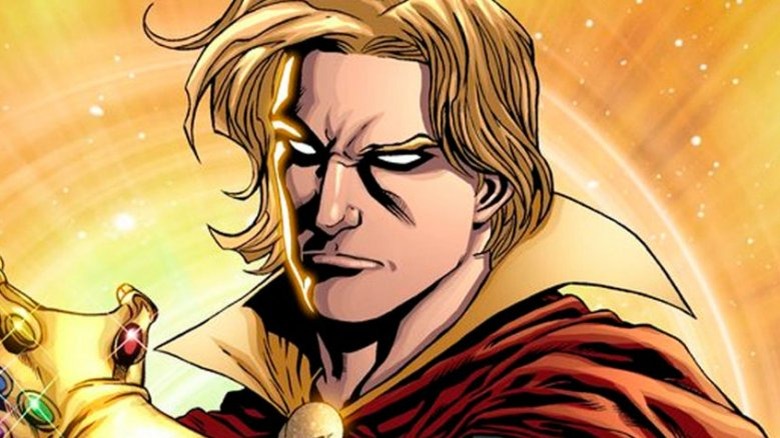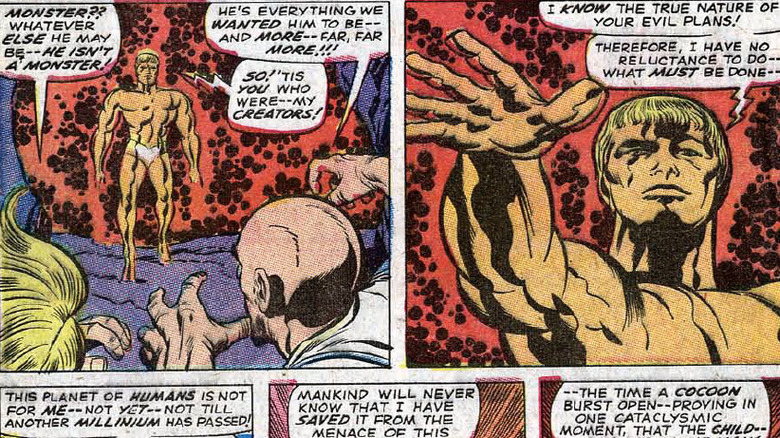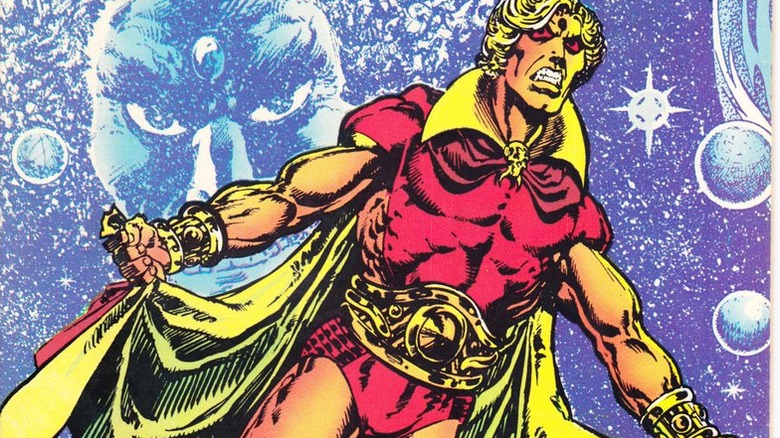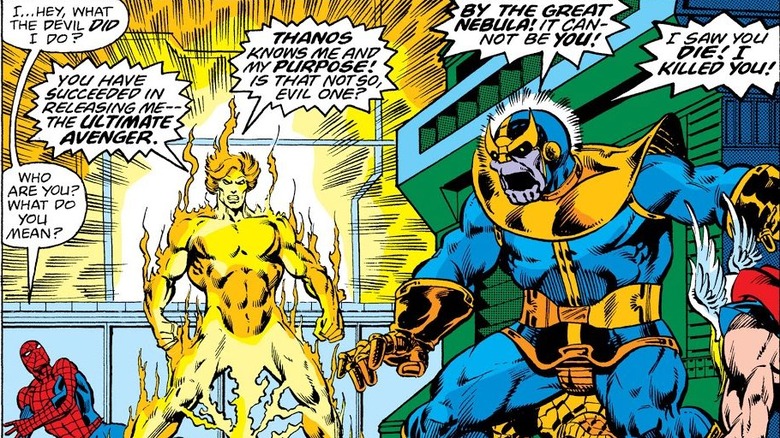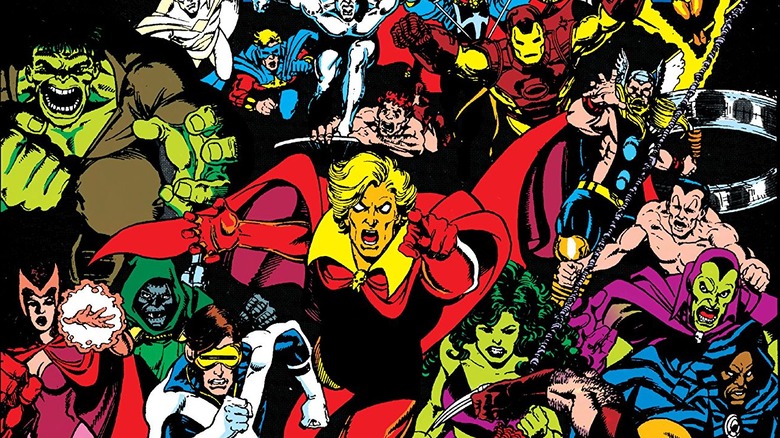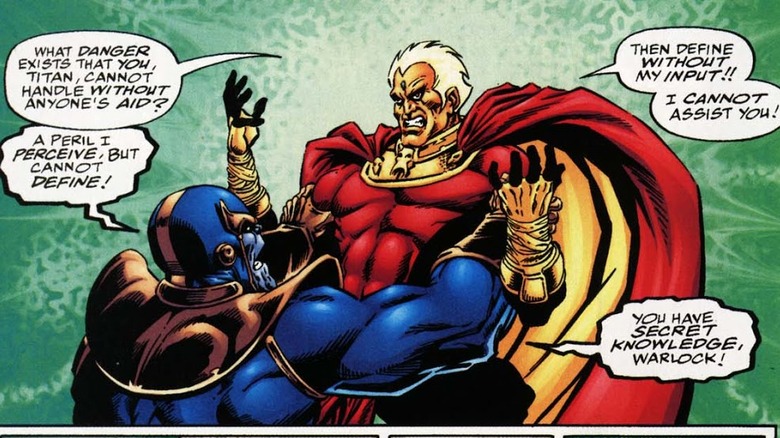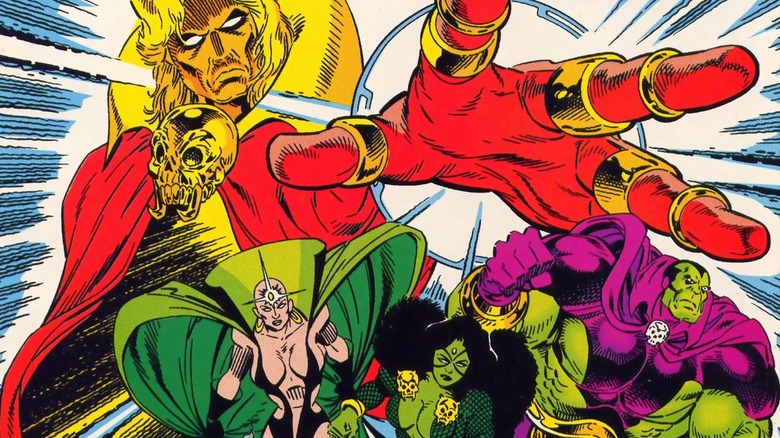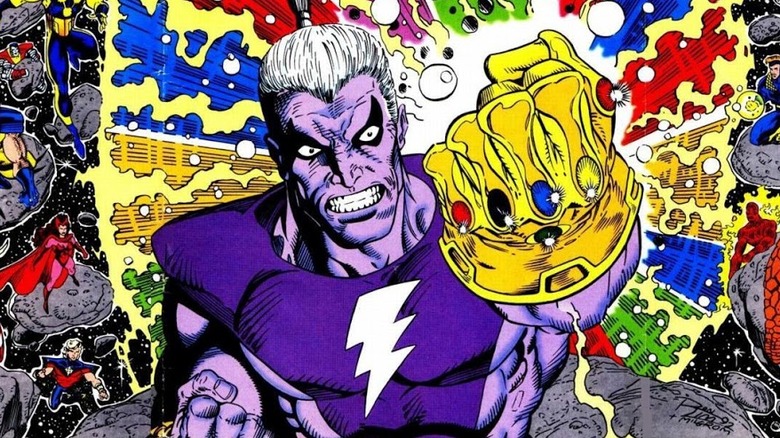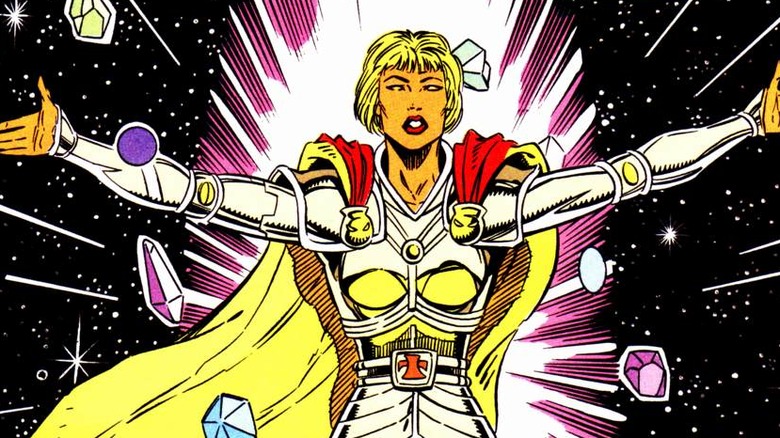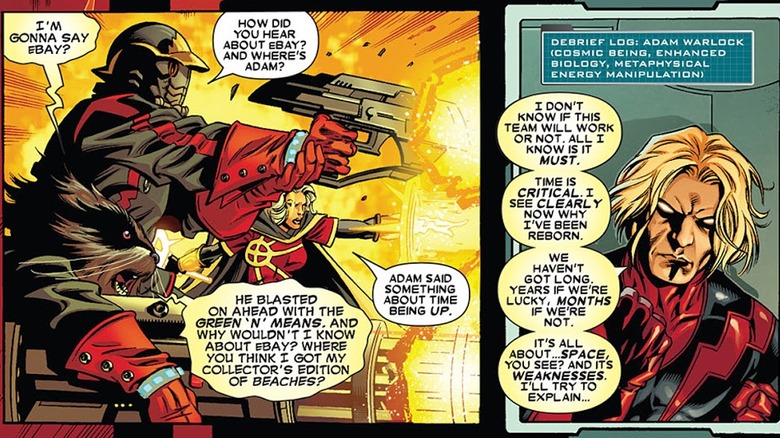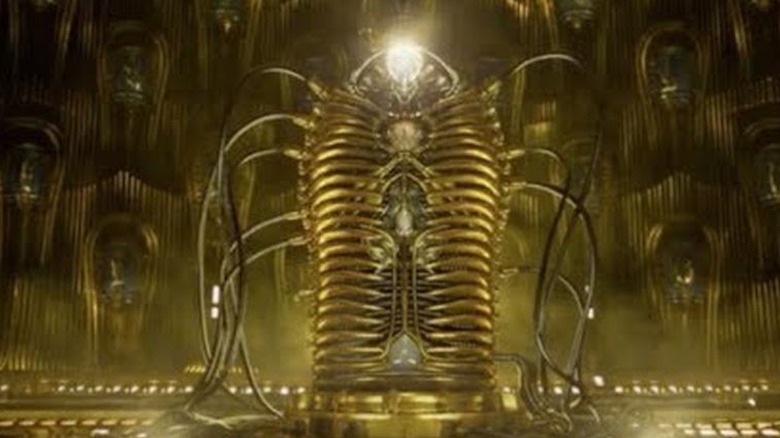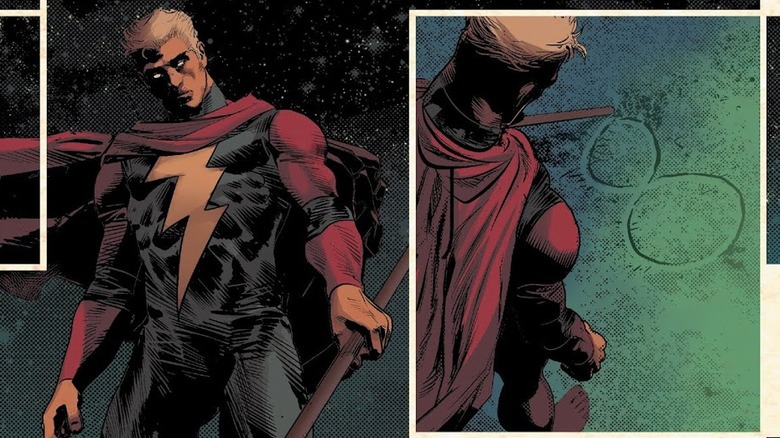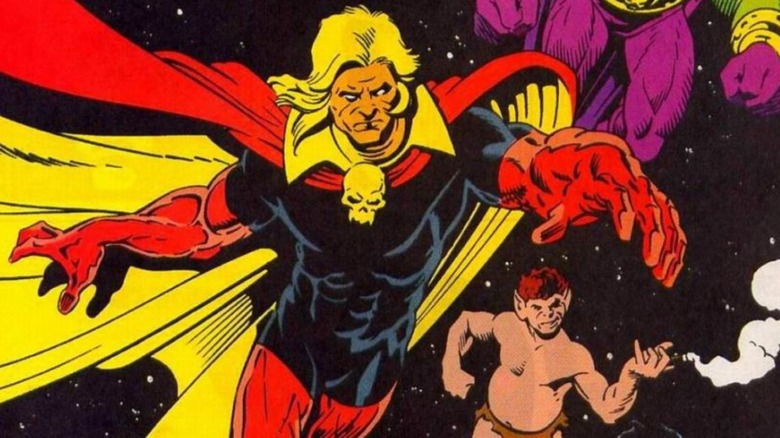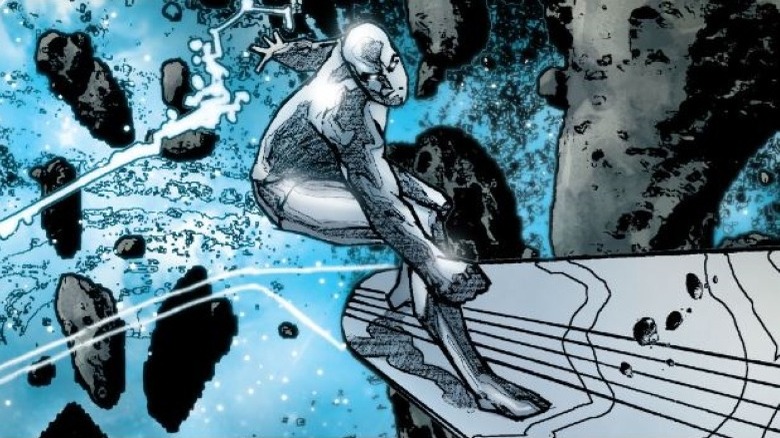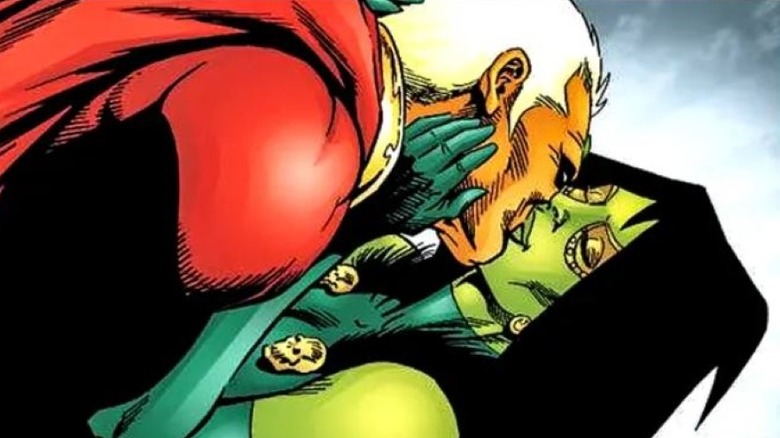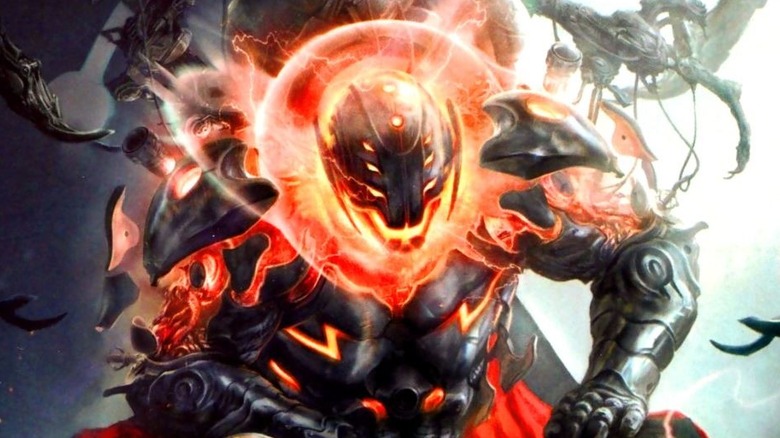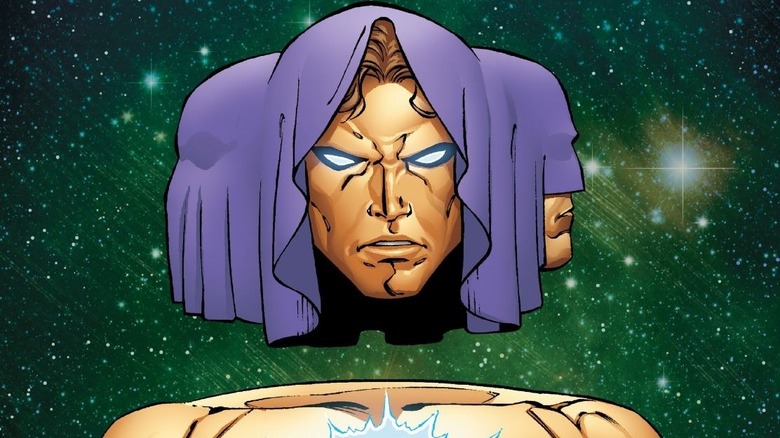What Comics Fans Know About Adam Warlock That You Don't
Adam Warlock is one of the more enigmatic figures in Marvel Comics. One of the heroes of Marvel's cosmic pantheon, Warlock sometimes skirts moral lines. If he's working towards an objective, then you can rest assured the stakes are something along the lines of the universe or reality itself, and from the gold-skinned wanderer's point of view, those stakes sometimes make just about any method or sacrifice justifiable.
Warlock has yet to appear in the MCU, and that's surprised a lot of comic fans. With Avengers: Infinity War and Endgame giving us a conclusion to the Thanos story that's been building since 2012's Avengers, many Marvel readers just assumed Warlock would show up. Not only has he been teased in the movies, but in the comics, Warlock is the foil to the Mad Titan. Seeing Thanos finally gather all six Infinity Stones and fight Marvel's heroes without Warlock being a part of it, to an old-school Marvel fan, is kind of like seeing the Avengers fight Green Goblin without Spider-Man.
When he finally does appear on the big screen, Adam Warlock may be new to you, but he's been wandering the spaceways of the Marvel Universe since the '60s. Here's a crash course for the uninitiated.
A child of the masters
Adam Warlock is a character usually associated with the comics of the '70s, but the truth is Warlock — like so many of Marvel's most successful icons — was created by the classic team of Stan Lee and Jack Kirby. Referred to initially as simply "Him," Warlock first appeared in the epic Lee/Kirby run on Fantastic Four, specifically Fantastic Four #66-#67. Two years later, the same creative team brought him back for three issues of Thor.
The Warlock of these early issues was little like the complex character he would become. While not unintelligent, this he is simple-minded and even infantile. In 1969's Thor #165, for example, he starts a fight with Thor because, desiring a mate, he abruptly proclaims about the warrior Sif, "She is pleasing to my eyes! Thus I do choose her!" He knocks Thor and Balder the Brave aside with a wave of his hand and kidnaps Sif.
Some layers were desperately needed before "Him" would get his own series... and a few lessons about manners and consent probably wouldn't hurt.
Adam Warlock Superstar
The one called "Him" got a new lease on life in the '70s. The character returned to the Marvel Universe in 1972's Marvel Premiere #1, this time as a fairly blatant messiah allegory. It's here that he encounters the High Evolutionary, who gives him the name "Warlock." The High Evolutionary creates a Counter-Earth spinning on the opposite side of the Sun from our Earth. Along with a planet, High Evolutionary creates a race of "New-Men," and the issue ends with him sending Warlock to Counter-Earth as his emissary and making Warlock part mortal. In case the hints are too subtle, early in the story High Evolutionary describes Warlock as "the one I would have made the son I never had."
The creative team heading Marvel Premiere #1 was made up of writer Roy Thomas and artist Gil Kane. In a 2009 interview in Back Issue!, Thomas admitted that his Warlock stories were largely inspired by the soundtrack to Jesus Christ Superstar. It's a surprising well to draw from, particularly considering the potential backlash. But Thomas said he was hopeful there would be no "outcry" because he "was not really making any serious statement on religion."
Considering the series Marvel Spotlight would suffer few protests the following year when its lead character became the Son of Satan, Thomas probably never had much to worry about.
The Titan killer
As much as any other medium or genre, superhero comics are known for characters dying and coming back so often that it's a wonder anyone in the Marvel Universe bothers with funerals. So, what's most surprising about Thanos' resurrection in 1990's Silver Surfer #34 isn't the return, but the fact that Marvel waited so long to bring him back. Thanos had first died over a decade earlier in 1977's epic Marvel Two-In-One Annual #2, and waiting 13 years to bring back a popular supervillain has to be some kind of record for Marvel. Ironically, the guy who killed Thanos? Adam Warlock, who was dead at the time.
Continuing from Avengers Annual #7, the story features the Avengers, the Thing, and Spider-Man (both of the latter heroes would have to wait a bit before being called Avengers themselves) in a huge battle against Thanos and his alien mercenaries. The battle is decided when Spider-Man sets loose the Soul Gem, and from it arises a fiery Adam Warlock. The vengeful Warlock kills Thanos by turning him to stone. It's the first time that, among a gathering of Earth's heroes, Adam Warlock is the key to defeating Thanos... but it's not the last.
A cosmic general
Marvel released the Infinity War mini-series in 1992, but it bears little resemblance to the movie Avengers: Infinity War. More than any other comic, the 1991 mini-series Infinity Gauntlet provided the inspiration for the 2018 film. The comic begins with Thanos having already gathered the six Infinity Stones, and the first issue ends with his infamous snap and the resulting universal purge. Like in the movie, the surviving heroes of Earth gather to fight a godlike Thanos to disastrous consequences.
The most conspicuous omission in the film is Adam Warlock. In Infinity Gauntlet, it's Warlock who gathers Earth's heroes at Doctor Strange's Sanctum Sanctorum, and it's Warlock who formulates the plan to defeat Thanos. He steps into darker moral shadows than most of the heroes, having a brief aside on the roof of the Sanctum with Hulk and Wolverine to make sure both are willing to kill Thanos if the chance arises. Warlock knows almost every last hero he recruits is destined to die. His plan is for the heroes to sacrifice their lives as a distraction, so that at just the right moment, Silver Surfer can snatch away the Titan's Gauntlet.
Warlock's plan fails, but luckily all the heroes are resurrected when Nebula seizes the Infinity Gauntlet from Thanos and uses it to reverse his deeds. By the end of the mini-series, Warlock holds the Gauntlet and all six Stones, and he doesn't care very much about whether or not Earth's heroes are okay with that.
Adam & Thanos: Best Frenemies
Adam Warlock and Thanos are often seen as being in constant opposition with one another, but the truth is that the two work together almost as much as they clash.
As soon as Infinity Gauntlet ends, Warlock turns to Thanos for help. After Warlock founds the Infinity Watch — a group whose members each safeguard one of the Stones — he secretly entrusts one of the Gems to Thanos, who becomes something a silent member of the team. When hostilities break out in Infinity Gauntlet's 1992 sequel Infinity War, Thanos and Warlock are allies once again, which does little to endear Earth's heroes to the Infinity Watch.
After a long break from the Infinity saga, writer/artist Jim Starlin returned with 2002's Infinity Abyss, and this time it's Thanos who seeks Warlock's help in stopping his vengeful Thanosi clones from destroying the universe.
While it seems strange sometimes, their uneasy alliances shouldn't come as a huge surprise. They usually have opposing goals and they don't like each other very much, but they're both powerful cosmic beings, they're both particularly attuned to the comings and goings of the universe, and they're each killed and resurrected so often that their caskets may as well be fitted with revolving doors.
Master of the Watch
Earth's heroes aren't thrilled when Adam Warlock claims possession of the Infinity Gems at the end of Infinity Gauntlet, and they aren't the only ones with a bone to pick. In 1992's Warlock & The Infinity Watch #1, Warlock is called to a gathering of Marvel's most powerful beings — characters like Eternity, the Living Tribunal, the Celestials, and more. These space gods aren't happy with Warlock's new omnipotence. He is initially resistant to their concerns, but eventually he agrees that he should not be the only being to wield all six Gems. Warlock forms the Infinity Watch — a team made up of cosmic heroes, each of whom would claim responsibility for one of the Gems. His first teammates include Moondragon, Gamora, Pip the Troll, and Drax the Destroyer. Warlock keeps the Soul Stone for himself and secretly gives the final stone to Thanos. Later in the series, Warlock admits to himself that his choices weren't the best, and that likely the Gauntlet's corrupting influence had more to do with the selections than his own will.
Warlock & The Infinity Watch ended after 42 issues in 1995, but the idea never died. Recently, the name "Infinity Watch" has popped up here and there in Marvel's comics, including in 2018's Infinity Countdown and again in its sequel, Infinity Wars, which sees an Infinity Watch led by Loki. Most recently, 2019's mini-series Wolverine: Infinity Watch has the freshly-resurrected Wolverine team up with Loki to protect the Stones' current owners.
The Magus
When Warlock takes possession of the Infinity Gems at the end of Infinity Gauntlet, he tries to be more responsible than its previous owners. Wielding all the Stones grants Warlock the same unlimited power it gave Thanos, and in order for him to be worthy of such a burden, Warlock decides he must become a being of pure logical reason, swayed neither by sentiment nor by his baser desires. Using his new power, Warlock purges himself of all good and evil, leaving nothing but logic. Maybe it sounds good in theory, but in pushing good and evil out of himself, Warlock creates two very big problems.
The first of those problems to strike is the Magus — Warlock's dark half — in the 1992 mini-series Infinity War. The Magus isn't new, though. When Jim Starlin first took the reins of Warlock in 1975's Strange Tales #178, he introduced an evil version of Warlock from the future named Magus. The Magus of Infinity War is the same being (minus an afro).
In Infinity War, Earth's heroes suddenly find themselves all accosted by vicious, evil copies of themselves, all of which turn out to be the creation of Magus. Magus' plans ultimately lead to the acquisition of the Infinity Stones... or so he thinks. The good guys win the day, but not without some help — villains like Doctor Doom, Kang, and Thanos also weigh in on the struggle against the Magus.
The Goddess
By the end of Infinity War, it's clear that Warlock's evil half isn't the only problem. In the 1993 sequel Infinity Crusade, the Goddess — the personification of Warlock's goodness — makes herself known by taking over the hearts and minds of half of Earth's heroes. The question of whether or not certain heroes are susceptible to the Goddess' control seems to be governed by their faith. Heroes with any kind of strong spiritual belief like Daredevil, Doctor Strange, and Storm fall under the Goddess' spell. Those heroes lacking such beliefs — particularly the more science-minded heroes like Mister Fantastic and Iron Man — are unmoved by her crusade.
The Goddess, like so many, proves her own worst enemy in the end. In her crusade to rid the universe of evil, she eventually decides the only way to make sure evil is snuffed out is to eradicate all sentient life. She uses a cosmic egg she's created to remake the universe in a new image, free of sentient life... or so she thinks. Foreseeing her plan, Warlock creates the illusion of the the Goddess' ideal existence. Not expecting this or a combined assault by Professor X, Warlock, and Thanos, the Goddess is defeated and sent to the world inside the Soul Stone.
One of the first Guardians... sort of
The Guardians of the Galaxy first appeared in 1969's Marvel Super-Heroes #18, but the team there has little in common with the group in the MCU. The original Guardians' story was set in the future and the heroes were freedom fighters rebelling against the alien Badoon who conquered Earth and all her colonies. The team was reinvented by Dan Abnett and Andy Lanning in 2008 in a new series set in the present and with a line-up much more similar to what Guardians movie fans are used to. It's this latter team in which Adam Warlock is a founding member.
Warlock remains an integral member of the Guardians until 2009's Guardians of the Galaxy #17, when the hero's attempts to restore the timeline cause him to transform into the Magus — his evil side personified — and die (again). Jim Starlin, who wrote many of Warlock's comics including all of the '90s Infinity stories, brought the gold-skinned space nomad back in his 2014 original graphic novel Thanos: The Infinity Revelation.
Ayesha's creation
Of the many easter eggs to be found in the Collector's (Benicio Del Toro) Knowhere showroom, one of the most oft-spotted is a large cocoon-like object first seen behind glass in 2013's Thor: The Dark World. This is meant to reference Adam Warlock. The character's weathered numerous rebirths through the years, and most end with him emerging from a cocoon very much like the one kept by the Collector. However, it seems like that reference is more or less retconned in 2017's Guardians of the Galaxy Vol. 2.
One of Vol. 2's mid-credits scenes begins with a defeated Ayesha (Elizabeth Debicki) staring at what looks to be a mechanical cocoon, or even a sarcophagus. As just about any Marvel Comics fan could have guessed upon seeing the thing, Ayesha tells us a creature is gestating in the cocoon, and the short scene ends with her naming the being inside "Adam." More than likely, Ayesha and her people, the Sovereign, already remind fans of Adam, because the golden skin looks exactly like Warlock's. But if there are any doubts, this scene eradicates them.
Unfortunately, we can't say Warlock is a lock for Guardians of the Galaxy Vol. 3. It's clear writer/director James Gunn wants to use him, but nothing has been confirmed. That Vol. 2 tease may never be more than a tease.
A hole in his heart
In the comics, Warlock's most recent significant appearance was in the 2018 mini series and event Infinity Wars. The event kicks off with the murder of Thanos by Gamora, and eventually sees Gamora do the exact opposite of her adoptive father with a new set of gathered Infinity Stones. Rather than killing half the people in the universe, Gamora cuts the number of people in half by combining them with one another. For example, Thor and Iron Man are combined to create Iron Hammer. Black Panther and Ghost Rider are fused to become Ghost Panther. Warlock enters the story when he senses there is something wrong with Soulworld — a world existing within the Soul Stone, of which he has often been the steward.
Infinity Wars ends with Warlock freeing the Infinity Gems. He uses the power of the Soul Stone to give all the Stones souls. Rather than claiming the Stones for himself, he releases all the gems except for the Soul Stone, saying they must "write their own destinies." When Star-Lord asks Warlock if he will keep the Soul Stone, Warlock says he will, but the Soul Stone doesn't agree. Before Warlock can finish answering Quill, the Stone shoots into the sky and disappears.
Infinity Wars #6 ends with Warlock in the desert, tracing an infinity symbol in the sand. The final page is a splash of Warlock looking sad and lost, saying, "I feel like a piece of me is missing."
Pip the Troll
It would be a shame to discuss Adam Warlock without bringing up his sidekick and best friend, Pip the Troll. Fans of the Marvel Cinematic Universe may recognize Pip from his film debut in "Eternals." During a mid-credit scene of the 2021 film, the troll, voiced by Patton Oswalt, magically appears to properly introduce the arrival of Starfox (Harry Styles). However, Pip's presence as the companion to Starfox is a bit of a misrepresentation of his comic book history. Although sharing the odd team-up with Thanos's brother Starfox, traditionally Pip the Troll is the companion of Adam Warlock.
Pip first appeared in "Strange Tales" Vol.1 #179 in 1975, where he meets Warlock and joins in the ongoing battle with Magus. The troll continued to be a loyal ally to Adam through many adventures, including after his death, when Pip's soul was captured within the Soul Gem. Residing in the Soulworld, Pip joined the Infinity Watch alongside Warlock and Gamora. And after Thanos was defeated in the "Infinity Gauntlet" event, Adam entrusted his trollish friend with the powerful Space Gem. With the power of teleportation stashed between his toes, Pip has joined many factions, including X-Factor, Ravagers, and was at one point employed by Thanos.
He can control Silver Surfer's cosmic board
The universe of Marvel Comics is full of cosmic beings and powerful gods. The Marvel Cinematic Universe has barely scratched the surface of the mythologies and entities that fill the stars around Earth. One of the most beloved space-bound Marvel characters is the Silver Surfer, also known as Norrin Radd. First appearing in "Fantastic Four" #48, Radd is imbued with cosmic powers and travels the galaxies on his uniquely powerful surfboard. Composed of the same cosmic materials that make up the Surfer's silvery form, Radd is able to mentally control the board and transform its shape at will.
Surprisingly, Norrin Radd is not the only being capable of controlling the shiny space-traveling surfboard. Silver Surfer and Adam Warlock have shared many things, including a battle with Thanos, a comic book title, and their souls. However, Warlock managed to surprise Surfer when he proved that they also share a connection with the cosmic surfboard. During the 1993 Thor-centered event "Blood and Thunder," the Asgardian went on a crazed rampage with only Norrin, Thanos, and the Infinity Watch to stand in his way. After taking a severe beating, Warlock was able to save his and Surfer's lives by mentally controlling the silver platform to carry them away in a desperate moment.
Gamora has a crush on him
Adam Warlock is set to make his official MCU movie debut, portrayed by Will Poulter in "Guardians of the Galaxy Vol. 3." While speculation builds around Warlock's impact during the film, the comic book source material may have given clues to an integral plot point. Audiences are already prepared for much of the upcoming feature to center around Peter Quill's search for Gamora. After the events of "Avengers: Endgame," a time-displaced Gamora abandoned the Guardians, ignorant of her future self's connection to the group. Equally unconnected to her romantic feelings for Quill, Gamora is left without her team, family, or purpose — leaving her open to new relationships in the universe.
In the comic books, Gamora spent much time in the Soul World after her death in "Avengers Annual" #7. There she teamed up with unlikely allies Pip the Troll and Adam Warlock. Forming the bones for the original Infinity Watch supergroup, Gamora spent years at Adam's side, developing an unrequited crush on the Jesus-like cosmic powerhouse. Whether a similar story plays out in the MCU is still unknown. However, when Will Poulter was questioned about the theory regarding the potential on-screen romance and their comic connection, he told The Movie Dweeb, "I didn't even know this. This is breaking news to me. Is that the expectation for Vol. 3?"
Ultron stole his body
Fans of the first MCU animated series "What If...?" were shocked when the eighth episode of the show featured the AI villain Ultron winning the events of "Avengers: Age of Ultron." The series continued to explore how Ultron infiltrates the body of Vision and begins the destruction of the multiverse. However, comic enthusiasts know that part of this story takes inspiration from the literary universe. But instead of Ultron slipping into the robotic body of Vision, his AI is inserted in the synthetic mind of Adam Warlock.
In the comic book event "Annihilation: Conquest," a cocoon containing Warlock is opened by Moondragon and Quasar. Disorientated and driven crazy by billions of dead souls calling upon him from the Soul World, Adam is captured by the techno-organic alien race known as Phalanx. The advanced species then inject the AI mind of Ultron into Adam's body, hoping for him to be a powerful general in their army. Subsequently, Ultron intends to clone his new overpowered body and build his own army to invade Earth. Thankfully, former X-Men Warlock manages to infect the Ultron-controlled body with a virus, forcing the robot's mind to flee. Meanwhile, the soul of Adam Warlock was once again saved by entering the Soul World in the Soul Gem.
The new Living Tribunal
An ongoing theme of Adam Warlock is that the character has progressively become more powerful. With each death and subsequent incarnation, Adam gains new abilities, including becoming a more magic-centered Warlock. In recent years, a version of Adam Warlock has become one of the most powerful forms in the entire universe: the Living Tribunal.
Essentially the judge of the most significant cosmic events of Marvel Comics, the Living Tribunal is considered the "highest authority in the Multiverse." He sits at the center of a court that features the most powerful entities in the known reality, such as Eternity, Infinity, Death, and The Celestials. Surprisingly, the Living Tribunal and much of his court were destroyed in "New Avengers" Vol.3 #30, when The Beyonders attempted to destroy the Multiverse in their perverse experiment.
At that time, in another part of the multiverse, Earth-616 and Earth-19141 were beginning to merge due to a battle between alternate versions of Thanos and Adam Warlock. The Adam of Earth-19141 was forced to absorb his own universe and replace the Warlock from 616. However, with too much power to control, this Warlock destroyed the 616 universe, leading him to request that the One-Above-All revive the reality. As part of their agreement, Adam Warlock-19141 became the new Living Tribunal for the reinstated universe, where he has remained since "Thanos: The Infinity Finale" in 2016.
Warlock's television appearances
After being hinted at multiple times in the MCU, Adam Warlock will finally have a speaking appearance in "Guardians of the Galaxy Vol. 3." While fans have been anticipating Warlock's arrival, nobody has wanted the character to appear in the MCU more than director James Gunn. "I love Adam Warlock. He's one of my favorite characters," Gunn said ahead of "Guardians of the Galaxy Vol. 2," mentioning that the character was intended to be a major part of that movie (per Slashfilm). "He was a big part of the screenplay, and I realized it was one character too many," said Gunn.
Still, comic book and cartoon fans never had to wait for the MCU to bring the overpowered space Jesus to the silver screen: Adam Warlock has been adapted for television on a few occasions. Warlock's first TV appearance took place in the short-lived 1998 "Silver Surfer" animated series in the episode "The Forever War." Later, Adam is a member of the Guardians of the Galaxy that appears in the 2010 micro-series "The Avengers: Earth's Mightiest Heroes." Most notably, Warlock is a significant part of the "Guardians of the Galaxy" animated show from 2015, where he grows from a baby to nearly destroying the Nova Corps single-handily over the course of the series. Meanwhile, Adam's first movie appearance took place as a non-speaking cameo in the 2010 "Planet Hulk" animated feature.
